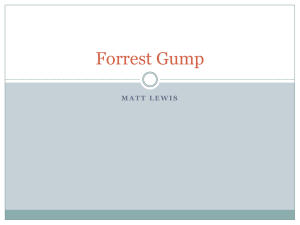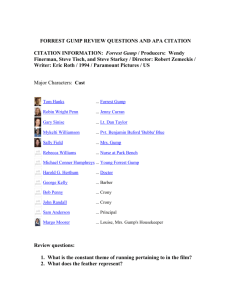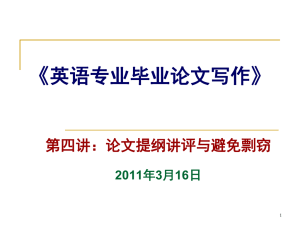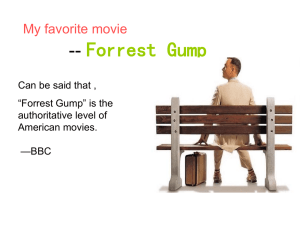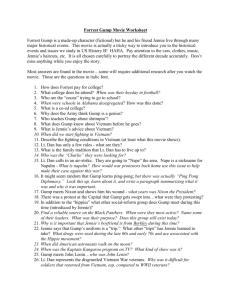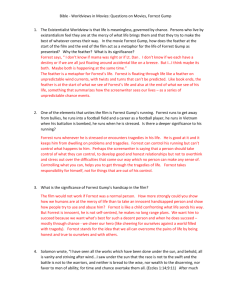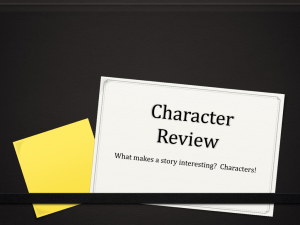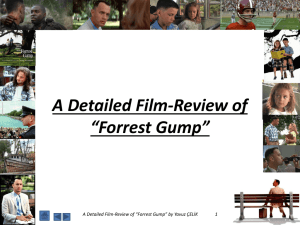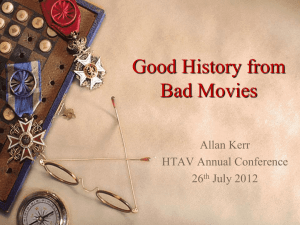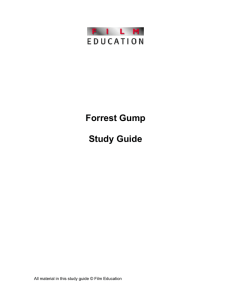Power Point Presentation: Case Study
advertisement
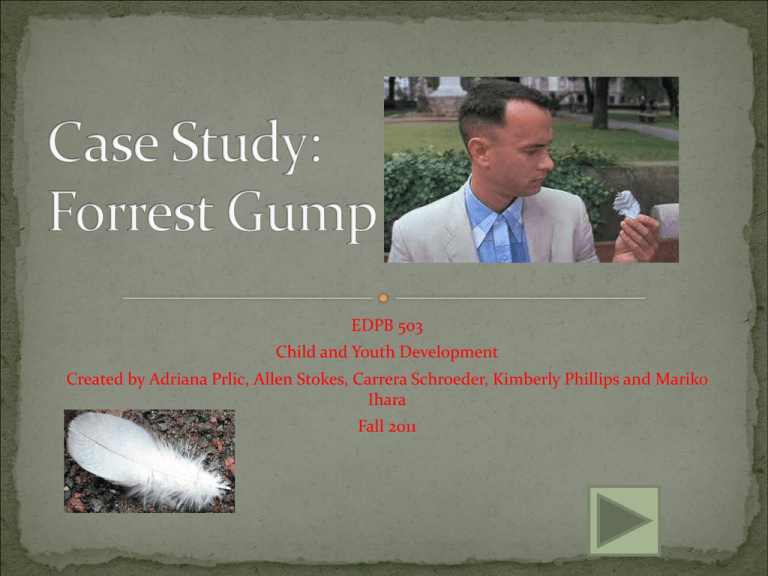
EDPB 503 Child and Youth Development Created by Adriana Prlic, Allen Stokes, Carrera Schroeder, Kimberly Phillips and Mariko Ihara Fall 2011 Forrest Gump – A Case Study Introduction – Kimberly Phillips Resource Teacher – Individual Education Plan - Adriana Prlic Role Play #1: - Allen Stokes Role Play #2: – Mariko Ihara Adolescence – Carrera Schroeder Evaluation Conclusion Credits Forrest Gump: A Case Study Forest Gump – Child and Adolescent Development We decided it would be interesting to focus our study on the fictional character of Forest Gump, as played by Tom Hanks, as he is shown to be a fascinating and endearing person. We have focused on the movie depiction of Mr. Gump, in contrast to the novel version, but do recognize that there are inconsistencies between the written story and the movie, with regards to his relationship to Jenny, and various other aspects of the story. How we came to the conclusion that Forrest Gump could possibly have Asperger’s Syndrome. 1. Asperger’s Syndrome is one of the disabilities included in the Autism Spectrum. These Children have the greatest trouble with social relations. 2. Language is less affected. Speech is fluent but unusual, mixing up pronouns of “I” and “you.” 3. Those with Asperger’s have average to above average intelligence. Social Relations: 1. 2. 3. 4. Asperger’s syndrome is characterized by qualitative impairement in social interaction: They are keen to relate to others, but do not have the skills, and may approach others in peculiar ways. They frequently lack understanding of social customs and may appear socially awkward, have difficult with empathy and misinterpret social cues. They often have their own perceptions, thoughts and feelings. They are also poor incidental social learners and need explicit instruction in social skills. Language Development: 1. 2. 3. Children with Asperger’s syndrome usually speak fluently by the time they enter Kindergarten, they often have complexities of language. Pragmatics – the use of language in social contexts Semantics - multiple meanings Prosody – the pitch, stress and rhythm of speech Dear God, make me a bird… Intelligences: 1. 2. 3. Students with AS are of average to above average intelligence and may appear quite capable. Many students are relatively proficient in their knowledge of facts and may extensive factual information about a subject that absorbs them. They demonstrate a relative weakness in comprehension and abstract thought, as well as in social cognition. Often have difficulty in cognitive flexibility – that is their thinking tends to be rigid – and with adapting to change or failure. They do not readily learn from their mistakes. Resource Teacher – Creating an IEP Does Forrest Gump Qualify for an IEP according to the standards indicated by the BC Ministry of Education: 1. The student with special needs requires more than just minor adaptations to educational materials, or instructional or assessment methods, or 2. The student with special needs is working on outcomes other than prescribed outcomes of the curriculum, or 3. The student with special needs is working on regular outcomes with little of no adaptations, but receives 25 hours or more of remedial help from someone other than the classroom teacher to meet the expected learning outcomes Teacher’s Concerns: •How can I best program for Forrest Gump and at the same time maintain an effective environment for the other students in my class? •What district personnel should we involve or contact in the planning for Forrest Gump’s program? •What goals should we (Resource Teacher and Education Assistants) set for Forrest Gump for this year and who can help us with developing an appropriate Individual Education Plan (IEP)? Participants: School Based Team Meeting Participants: •Resource Teacher •School Principal •School Counsellor •Speech Language Therapist •Forrest Gump’s parent •The Student – Forrest Gump •View plan here Parts of Program Implementation: Program Implementation Ideas: Support: •Collaborate regularly with School based team Participants •Use home-school book For ongoing communication With Forrest Gump’s mother •Set up a buddy system With the class Academic: •Use Structured program to Develop fine motor skills •Read Stories with Forrest and Talk to him about them. Perhaps Use student teacher, older school buddy/pee and his mother •Have Forrest start a scrap book With magazine cut-outs and Drawings under emotional Headings to help him progress To make multiple meanings from Text he observes Teaching Tips For Children with Asperger’s Social/Behaviour: •Include Forrest Gump in social Skills groups run by the resource Teacher, Principal or community Group with children with AS •Engage Forrest in socially interactive Activities within the classroom and in The school •Establish a circle of friends program in the classroom where Forrest May have opportunities to interact With peers which will help him Learn to communicate in a Variety of different situations Resource Teacher takes initiative: Role of Teacher – Mariko Ihara Role of Cognitive Development Specialist – Allen Stokes Erik Erikson – Stages of Psychological Development: Allen 1. 2. 3. 4. Industry vs. Inferiority: Age 6 to 12 Cognitive development proceeding rapidly Children can process more information faster and their memory spans are increasing Children experiencing ability to move between the worlds of home, neighbourhood, and school and to cope with academics, group activities, and friends will lead to a growing sense of competence in children In school setting children must reestablish stage of psychosocial development in the unfamiliar school setting. They must learn which new adults they can trust, act autonomously in this more complex situation, and intiate actions in ways that fit the new rules of school. IQ of 75… 2011 Intervention: Role of Teacher – Mariko Ihara Role of Forrest Gump’s Parent – Allen Stokes Developmental Stage of Middle childhood: Mariko Self-concept: our integrated view of the attributes, abilities, and attitudes that define us. In middle childhood children begin to recognize and acknowledge their strengths and limitations in relation to the standards set for a particular task and domains of activity. More balanced and realistic. Self-esteem: The self-evaluative part of the self-concept, the judgements children make about their overall self-worth. In middle childhood this becomes more differentiated as they experience success and failures in a variety of domains. Self-regulation: During middle childhood children advance in emotional self-regulation, that enables individuals to remain focused on goals, even in the face of difficult and stressful circumstances. Jean Piaget – Four Steps of Formal Operations: 1. Deductive and Inductive Reasoning 2. Hypothetical Deductive Reasoning 3. Ability to reason without Combinations 4. Reasoning like a Scientist Epistemological Beliefs and Critical Thinking: Carrera Absolutist Stage: Middle Childhood •Assertions are FACTS that are correct or incorrect in their representation of reality •Knowledge is from an external source and it certain but not directly accessible – producing false beliefs •Critical Thinking is a vehicle for comparing assertions to reality and determining their truth or falsehood Multiplist Stage: Adolescence •Assertions are OPINIONS freely chosen by and accountable only to their owners •Knowledge is generated by human minds and therefore uncertain •Critical Thinking is irrelevant •View Group Rubric here What actions would you take with students like Forrest Gump in your class? How would your method different or similar to what we came up with? Do you agree that Forrest Gump might have Asperger’s syndrome and why? Photos and images accessed from: http://www.flickr.com/photos/heraldpost/3214591519/si zes/m/in/photostream/ www.google.com Students with Intellectual Disabilities – Resource Guide for Teachers: http://www.bced.gov.bc.ca/specialed/sid/app1.htm Ernst O. Vanbergeijk and Oren Shtayermman. “Asperger’s Syndrome: http://dx.doi.org/10.1300/J137v12n01_02
